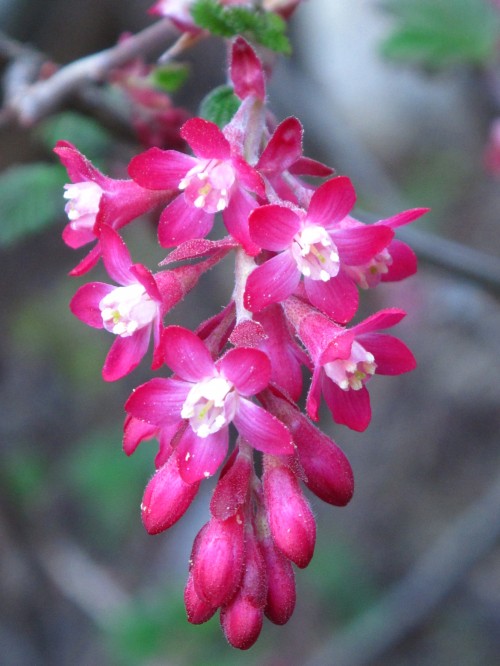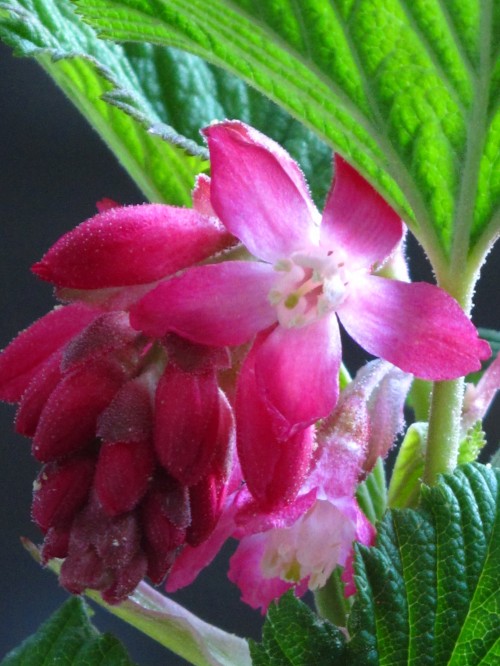But To Carry On: Ribes has Arrived!
 The anticipation was torture for an amateur botanist from southern climes. It took three weeks for the tight buds to finally crack and unfurl into star-shaped flowers. Three weeks, after months of the bare twigs and snow-smothered ground cover of winter. But, one by one, the red-flowering currant (Ribes sanguineum) that is planted around the landscaped areas at the Environmental Learning Center began to claim its seasonal distinction as the first blooming plant of spring. Its species name — sanguineum — is appropriate, derived from the Latin sanguineus, or bloody. This early color lends a flushed optimism to the sunny edges of the forest, full of life amidst the still withered and brown remnants of the stubborn oceanspray (Holodiscus discolor), another tall and lanky flowering shrub characteristic of these parts. Ribes’ tubular flowers attract hummingbirds, which are also set to arrive in the upper Skagit Valley after a winter vacation in Mexico and Central America. Anyone with one of those plastic hummingbird feeders, full of red #40-dyed sugar water, knows that these winged pollinators best see colors in the long-wave light spectrum — reds, oranges, and violet-reds.
The anticipation was torture for an amateur botanist from southern climes. It took three weeks for the tight buds to finally crack and unfurl into star-shaped flowers. Three weeks, after months of the bare twigs and snow-smothered ground cover of winter. But, one by one, the red-flowering currant (Ribes sanguineum) that is planted around the landscaped areas at the Environmental Learning Center began to claim its seasonal distinction as the first blooming plant of spring. Its species name — sanguineum — is appropriate, derived from the Latin sanguineus, or bloody. This early color lends a flushed optimism to the sunny edges of the forest, full of life amidst the still withered and brown remnants of the stubborn oceanspray (Holodiscus discolor), another tall and lanky flowering shrub characteristic of these parts. Ribes’ tubular flowers attract hummingbirds, which are also set to arrive in the upper Skagit Valley after a winter vacation in Mexico and Central America. Anyone with one of those plastic hummingbird feeders, full of red #40-dyed sugar water, knows that these winged pollinators best see colors in the long-wave light spectrum — reds, oranges, and violet-reds.
 You’re right: This feeding of wildlife did not occur in North Cascades National Park but was taken on a trip to the Monteverde Cloud Forest in Costa Rica. A hanging row of plastic feeders was attended by dozens of colorful hummingbird species, sucking down enough artificial nectar in order to obtain their requirement of half their weight in food daily. Photo by author.
You’re right: This feeding of wildlife did not occur in North Cascades National Park but was taken on a trip to the Monteverde Cloud Forest in Costa Rica. A hanging row of plastic feeders was attended by dozens of colorful hummingbird species, sucking down enough artificial nectar in order to obtain their requirement of half their weight in food daily. Photo by author.
The white petals surrounded by the flashy pink sepals (aka “bud covers”) are like a neon sign throbbing around an otherwise inconspicuous target, alerting potential pollinators that this is where the goods are. Since hummingbirds have almost no sense of smell, flowers pollinated by the buzzing birds have no need to waste energy on manufacturing fragrance. Ribes are no exception. The individual flowers are small, only about half-an-inch wide. This lack of girth is compensated by their arrangement in a larger cluster, known in botanical circles as an “inflorescence”, which hangs down like a handful of succulent grapes, offering an easy one-stop buffet for hungry pollinators and a clear area for the assertive approach of a determined hummingbird.
 Ta da! Bow down to the first blooming plant of spring! From L to R: Seasonal naturalist Oliver Wood, graduate student and staff Tyler Chisholm, and seasonal naturalist Allison Andrews. Photo by author.
Ta da! Bow down to the first blooming plant of spring! From L to R: Seasonal naturalist Oliver Wood, graduate student and staff Tyler Chisholm, and seasonal naturalist Allison Andrews. Photo by author.
Though perhaps not as tasty as the hummingbird’s nectar, uses of this species have been found by humans, as well. According to Daniel Matthews in his comprehensive field guide, Cascade-Olympic Natural History, Ribes is the Arabic term for “rhubarb”, which makes sense considering its hot pink hue. In their Plants of the Pacific Northwest Coast, Pojar and MacKinnon call the bluish-black, round berries “unpalatable” and “insipid” (author’s note: As a gardener who is always excited to nibble straight from the source, I would argue otherwise.). Various Coast Salish groups eat them fresh if necessary, but they are not preferred. No big deal, though, for now: Spring is the time not for berries, insipid or no, but for flowers. Rejoice, rejoice, we have no choice! Happy Spring, everyone!
 Leading photo: A Ribes inflorescence. The individual flowers take a couple of weeks to open from the base to the tip, an adaptation allowing the plant to be available to pollinators for as long as possible, thus increasing its chances of reproductive success. Photo by author.
Katherine Renz is a graduate student in North Cascades Institute and Western Washington University’s M.Ed. program. Had she had any foresight, she would have joyously written the book, Sex in the Garden, before author Angela Overy did. Are you similarly obsessed with flowers and pollination? It’s a must-read!
Leading photo: A Ribes inflorescence. The individual flowers take a couple of weeks to open from the base to the tip, an adaptation allowing the plant to be available to pollinators for as long as possible, thus increasing its chances of reproductive success. Photo by author.
Katherine Renz is a graduate student in North Cascades Institute and Western Washington University’s M.Ed. program. Had she had any foresight, she would have joyously written the book, Sex in the Garden, before author Angela Overy did. Are you similarly obsessed with flowers and pollination? It’s a must-read!

